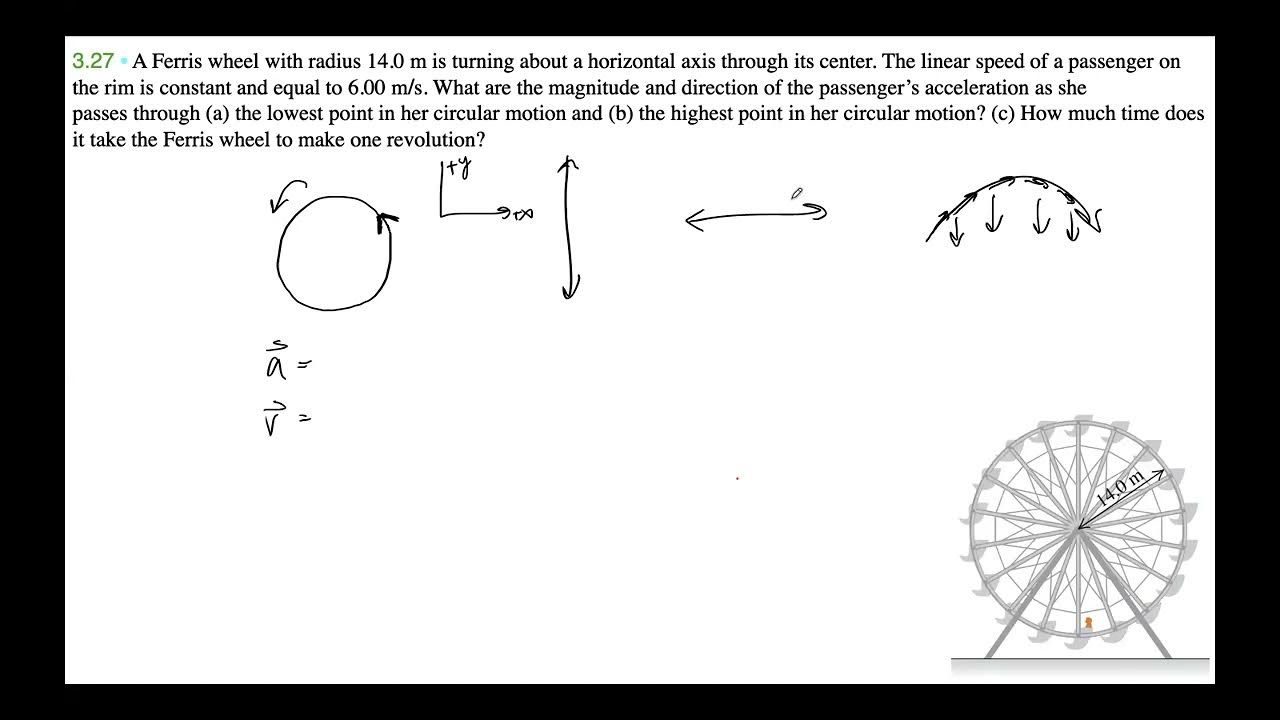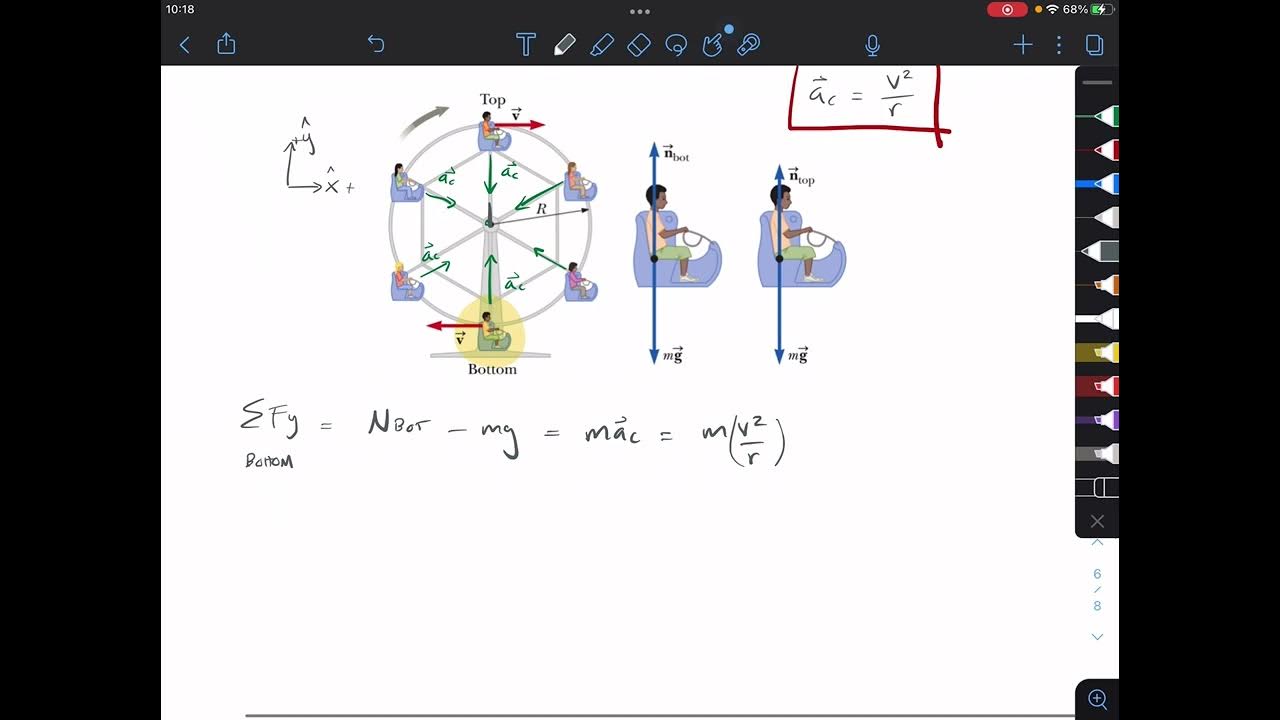Uniform Circular Motion, Example #1 Ferris wheel
TLDRIn this example, the presenter explains the motion of a woman on a Ferris wheel with a radius of 15 meters completing five turns in one minute. The tasks include calculating the period of the Ferris wheel, finding the centripetal acceleration at the highest and lowest points. The period is found to be 12 seconds. Using this, the centripetal acceleration at the top is calculated as 4.11 m/s^2 directed downward. At the bottom, the centripetal acceleration is also 4.11 m/s^2 but directed upward. The explanation emphasizes understanding the direction of acceleration in circular motion.
Takeaways
- 🎡 The scenario involves a woman traveling in a Ferris wheel with a radius of 15 meters.
- ⏱ The Ferris wheel completes five turns in one minute, which is used to calculate the period.
- 🕒 The period (T) is the time for one complete revolution, calculated as 60 seconds divided by 5, resulting in 12 seconds.
- 🚀 In Part B, the centripetal acceleration at the top of the Ferris wheel is to be found using the formula velocity squared divided by radius.
- 📐 The velocity is calculated as the distance around the circle (2πR) divided by the period, yielding approximately 7.85 meters per second.
- 🔢 The centripetal acceleration at the top is calculated to be 4.11 m/s², directed downwards towards the center of the circle.
- 🔄 The same equation is used to find the centripetal acceleration at the bottom of the Ferris wheel in Part C.
- 📉 At the bottom, the magnitude of the centripetal acceleration remains 4.11 m/s², but the direction is upwards, away from the center of the circle.
- 🧭 The direction of centripetal acceleration is always towards the center of the circular path, changing based on the position (top or bottom).
- 📚 The script explains the concept of centripetal acceleration and its calculation, emphasizing its directionality due to the changing position in a circular motion.
Q & A
What is the radius of the Ferris wheel mentioned in the script?
-The radius of the Ferris wheel is given as 15 meters.
How many turns does the Ferris wheel complete in one minute?
-The Ferris wheel completes five turns in one minute.
What is the period (T) of one complete revolution of the Ferris wheel?
-The period (T) of one complete revolution is calculated to be 12 seconds.
What is the formula for calculating the centripetal acceleration at any point on the Ferris wheel?
-The formula for centripetal acceleration is the velocity squared divided by the radius (a_c = v^2 / r).
How is the velocity of the woman on the Ferris wheel calculated?
-The velocity is calculated by dividing the distance around the circle (2πr) by the period (T).
What is the approximate velocity of the woman on the Ferris wheel?
-The approximate velocity of the woman is 7.85 meters per second.
What is the centripetal acceleration at the highest point of the Ferris wheel?
-The centripetal acceleration at the highest point is 4.11 meters per second squared, directed downwards.
What is the direction of the centripetal acceleration at the top of the Ferris wheel?
-At the top of the Ferris wheel, the centripetal acceleration is directed downwards towards the center of the circle.
What is the centripetal acceleration at the lowest point of the Ferris wheel?
-The centripetal acceleration at the lowest point is also 4.11 meters per second squared, but the direction is upwards.
What is the direction of the centripetal acceleration at the bottom of the Ferris wheel?
-At the bottom of the Ferris wheel, the centripetal acceleration is directed upwards towards the center of the circle.
Why does the direction of centripetal acceleration change between the top and bottom of the Ferris wheel?
-The direction of centripetal acceleration changes because it always points towards the center of the circle, which is vertically downward at the top and upward at the bottom.
How does the script illustrate the concept of centripetal force and acceleration?
-The script uses the example of a woman on a Ferris wheel to illustrate how centripetal force and acceleration are calculated and directed towards the center of the circular path.
Outlines
🎡 Physics of a Ferris Wheel Ride
The script introduces a physics problem involving a woman on a Ferris wheel with a 15-meter radius. She completes five revolutions around a horizontal axis in one minute. The task is to calculate the period of rotation (Part A), the centripetal acceleration at the highest point (Part B), and at the lowest point (Part C). The period is determined to be 12 seconds by dividing the total time of one minute (60 seconds) by the number of turns (5). To find the centripetal acceleration, the script uses the formula which involves the velocity squared divided by the radius. The velocity is calculated by the distance traveled (2πR) over the period. After calculating the velocity to be approximately 7.85 meters per second, the centripetal acceleration is found to be 4.11 m/s², directed towards the center of the Ferris wheel. The direction of this acceleration changes depending on whether the woman is at the top or bottom of the wheel, with it being downward at the top and upward at the bottom.
Mindmap
Keywords
💡Ferris Wheel
💡Radius
💡Period
💡Centripetal Acceleration
💡Velocity
💡Horizontal Axis
💡Highest Point
💡Lowest Point
💡Turns
💡Direction of Acceleration
Highlights
A woman is traveling in a Ferris wheel with a radius of 15 meters.
The Ferris wheel completes five turns in one minute.
Part A requires finding the period of the Ferris wheel's rotation.
The period is the time taken for one complete revolution.
The period is calculated as 60 seconds divided by 5, resulting in 12 seconds.
Part B asks for the centripetal acceleration at the highest point.
Centripetal acceleration is velocity squared divided by the radius.
Velocity is calculated as the distance around the circle divided by the period.
The calculated velocity is approximately 7.85 meters per second.
Centripetal acceleration at the top is 4.11 meters per second squared, directed downwards.
Part C requires finding the centripetal acceleration at the lowest point.
The same equation is used for centripetal acceleration at the bottom.
The acceleration at the bottom is also 4.11 m/s^2, but directed upwards.
The direction of centripetal acceleration changes depending on the position on the Ferris wheel.
The activity will demonstrate how centripetal acceleration always points towards the center.
At the top, the centripetal acceleration is downwards, while at the bottom, it is upwards.
Transcripts
5.0 / 5 (0 votes)
Thanks for rating:





